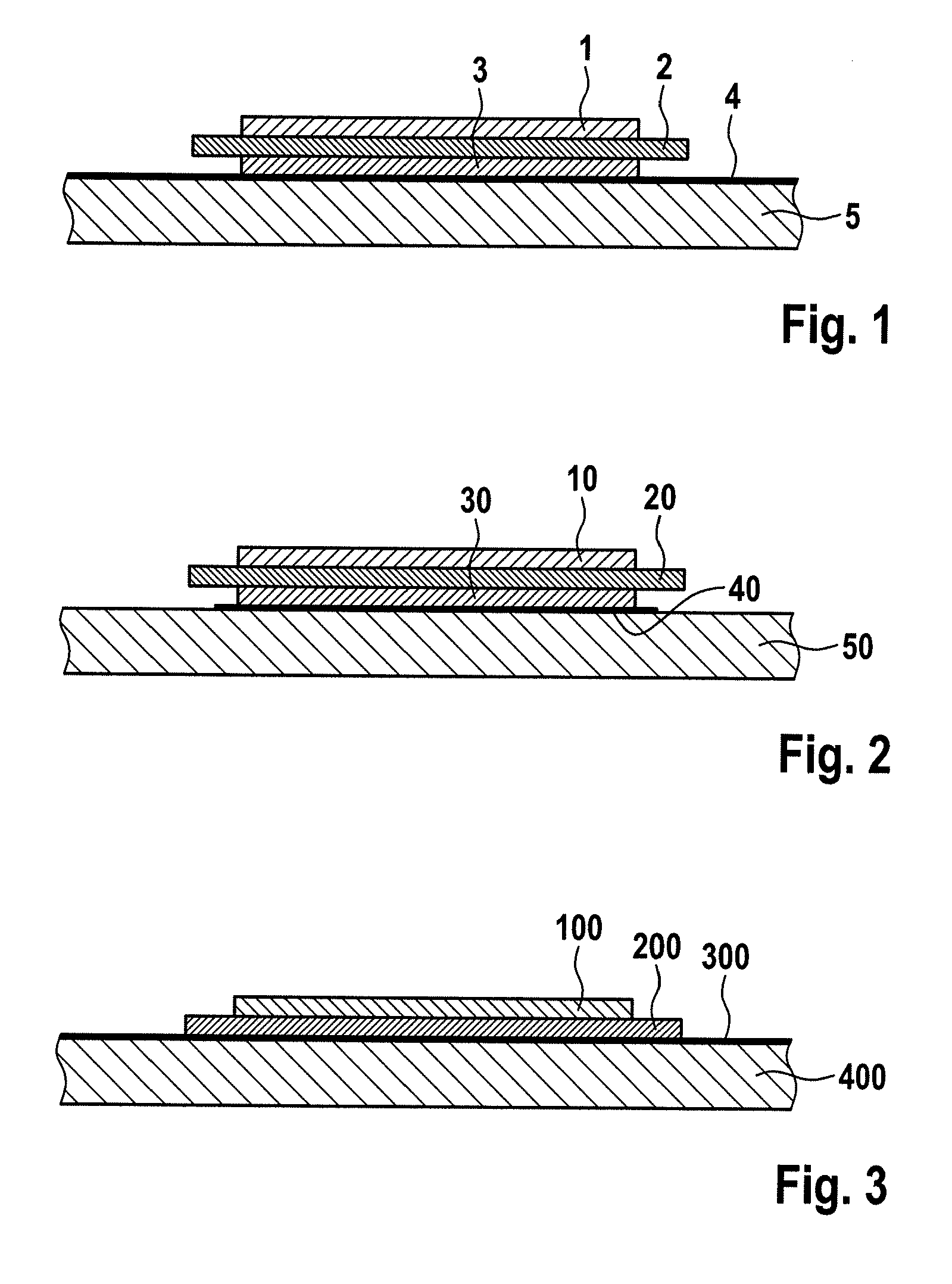Method of Joining Metal-Ceramic Substrates to Metal Bodies
a metal-ceramic substrate and metal body technology, applied in gaseous cathodes, electric discharge lamps, electrical apparatus, etc., can solve the problems of reducing heat transfer, failure of components, and unsuitable for fastening, and achieve stronger and more stable bonding of metal bodies, better long-term properties, and better property profiles
- Summary
- Abstract
- Description
- Claims
- Application Information
AI Technical Summary
Benefits of technology
Problems solved by technology
Method used
Image
Examples
example 1
Joining of DAB Substrates Metallized on Both Sides and Structured on One Side to an Al—Si-Coated Aluminium Sheet
[0095]In this example, DAB ceramic substrates having a lateral size of 36 mm×20 mm (Al2O3 ceramic (thickness 0.38 mm) with Al metallization (thickness 0.3 mm) on both sides, where the upper side of the DAB substrate is structured for a circuit) are joined to a 0.2 mm thick aluminium sheet coated on one side with Al—Si.
[0096]For the joining process, the substrates to be joined are placed with the unstructured side on the Al—Si-coated side of the aluminium sheet in defined positions.
[0097]An in-principle sketch through the cross section of the structure is shown in FIG. 1, where the metallized ceramic substrate comprises a ceramic 2 and metallization 1 and 3 on both sides and the joining layer 4 is firmly joined to the aluminium sheet 5.
[0098]This stack is placed on the conveyor belt of a tunnel kiln having a plurality of heating zones and is moved at a constant transport sp...
example 2
Joining of a Structured DAB Substrate to an Aluminium Sheet by Means of Loosely Laid Al—Si Plates
[0100]In this example, a DAB ceramic substrate having a lateral size of 36 mm×20 mm (Al2O3 ceramic (thickness 0.38 mm) with Al metallization (thickness 0.3 mm) on both sides) is joined to a 0.8 mm thick Al sheet, with the upper metallization of the DAB substrate being structured for a circuit. Before the joining process, an Al—Si plate having a size of 36 mm×20 mm and a thickness of 0.075 mm for each substrate to be joined is placed in the defined positions on the upper side of the aluminium sheet and the unstructured underside of the ceramic substrate is positioned thereon.
[0101]An in-principle sketch through the cross section of the structure is shown in FIG. 2, where the metallized ceramic substrate comprises a ceramic 20 and metallization 10, 30 on both sides, the joining layer 40 is made up of plates and the aluminium sheet is denoted by the reference numeral 50.
[0102]This stack is ...
example 3
Joining of DCB Substrates Metallized and Structured on One Side to an Al—Si-Coated Aluminium Sheet
[0104]In this example, DCB ceramic substrates having a lateral size of 36 mm×20 mm (Al2O3 ceramic (thickness 0.63 mm) and Cu metallization (thickness 0.3 mm) applied only to its upper side) is joined on its uncoated underside to a 0.5 mm thick aluminium sheet coated on one side with Al—Si. The copper metallization of the DCB substrates is structured for a circuit.
[0105]For the joining process, the ceramic substrates to be joined are placed with the metallization facing upwards onto the Al—Si-coated side of the Al sheet. An in-principle sketch through the cross section of the structure is shown in FIG. 3, where the metallized ceramic substrate comprises metallization 100 and a ceramic 200 and the joining layer 300 is firmly joined to the aluminium sheet 400.
[0106]The join is produced between the ceramic of the substrate and the aluminium sheet (including intermediate layer). This stack i...
PUM
| Property | Measurement | Unit |
|---|---|---|
| thickness | aaaaa | aaaaa |
| liquidus temperature | aaaaa | aaaaa |
| temperature | aaaaa | aaaaa |
Abstract
Description
Claims
Application Information
 Login to View More
Login to View More - R&D
- Intellectual Property
- Life Sciences
- Materials
- Tech Scout
- Unparalleled Data Quality
- Higher Quality Content
- 60% Fewer Hallucinations
Browse by: Latest US Patents, China's latest patents, Technical Efficacy Thesaurus, Application Domain, Technology Topic, Popular Technical Reports.
© 2025 PatSnap. All rights reserved.Legal|Privacy policy|Modern Slavery Act Transparency Statement|Sitemap|About US| Contact US: help@patsnap.com


